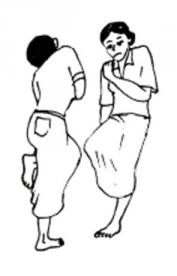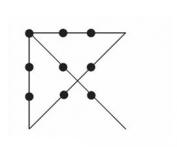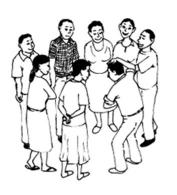Energisers raise the energy level of a training session by gaining back people’s attention and interest and therefore improving the training by itself. Enjoyable activities which refresh the group can be incorporated within a training course in order to stimulate the participants either physically, mentally or at best both together. It is very important to adjust the type of energisers as well as the required time frame and material to the specific context of the training.
During meetings, workshops or training sessions there may be times when energy levels are very low and people’s attention is fading. This is most likely happening at the end of the morning, just after lunch or towards the end of the day. Incorporating enjoyable breaks between training sessions makes it easier to cope with difficult presentations, high temperatures and challenging decisions.
These enjoyable activities that help to refresh people are called energisers. Furthermore, these energisers can help participants to get to know each other better and break down barriers and bring people from different backgrounds together (see also icebreakers). Energisers are very useful techniques which physically and mentally stimulate participants in order to resume further training activities (ARCHER TRAINING 2010; UNESCO 2004).
However, choosing an appropriate energiser is not an easy task. Some of them require a degree of openness or familiarity that is not comfortable for all participants. Be careful when energiser involve physical contact, or when mixing female and male participants. Sometimes it may be more appropriate to switch the training method (such as group works, discussions or role plays) than using an energiser - but in some situation, an energiser is just exactly what people need to be stimulated.
There are two kinds of energisers: those that require physical movement and those that require mental work or exercise. It is the decision of the lecturer which is the most appropriate for a particular context of training. By implementing energisers we can develop a sense of team spirit among the participants that can create a pleasant atmosphere for learning.
Facilitators often prefer to implement physical energisers in order to more effectively refresh participants during long sessions (UNESCO 2004).

Participants are playing the physical stimulating “Mirrors” game. Source: TEARFUND (2005)
(Adapted from CAMPUUS n.y.; TEARFUND 2005; UNESCO 2004)
Based on physical stimulation:
Mirrors
Time required: 5-10 minutes / Group size: any size
- Ask the participants to form groups of two persons
- One person is the actor and the other participant is the mirror
- The mirror does whatever the actor does means mirroring their actions
- After a few minutes, change the roles
Wink
Time required: 20-30 min / Group size: up to 20 persons
- Have members stand in a circle with their eyes closed
- One person walks around the circle and quietly taps the back of one person who will be the “winker”
- Everyone opens their eyes and begins to mill around the room
- If a person has been winked at, she or he must count to ten silently and then make a scene to let others know she or he is out of the game
- The object is to catch the winker before everyone loses. If a person suspects the winker’s identity, she says, “I have an accusation!” However, there must be two accusers to stop the game
- When someone else becomes suspicious, she or he shouts, “I have an accusation!” Then both accusers count to three and point to the player they think is the perpetrator (no discussion is allowed). If they both point to someone who is innocent or to different people, they are automatically out of the game. When they both point to the true winker, the game is over.
Based on mental stimulation:
Nine Dots
Time required: 5-10 minutes / Group size: any size

Solution for the “Nine Dot” game. Source: UNESCO (2004)
- Distribute to each participant a piece of paper and a pen
- Draw nine dots on the chalkboard or whiteboard
- Ask participants to draw nine dots on their paper and ask them to do the following:
• Dots must be joined by four straight lines
• Pen should not be pulled off the paper - The participant who can join nine dots before anyone else will be the winner
- Let the others try until most of them are successful
- Finally ask any of the participants to show how she/he joined the nine dots
What's on your Back
Time required: 5-10 minutes / Group size: up to 20 persons
- In this exercise the participants will be asked to identify what is written on their backs
- Write any name (a person, an object, etc.) on a piece of paper
- Attach this paper to the back of a participant
- Ask him/her to identify what is written on the paper by asking the other participants questions. Participants can only answer yes or no. They will not be allowed to give any hints while replying (Ask 10-15 questions)
- If the participant fails to answer, try it with another person
Numbers
Time required: depending on group size / Group size: up to 20 persons

Participants are playing the physical stimulating “Numbers” game. Source: TEARFUND (2005)
- Ask the participants to stand in a circle
- The participants have to count in turn around the circle
- Every time the number five or a multiple of five is reached, that person claps instead of saying the number
- Every time the number seven or a multiple of seven is reached, that person turns around once instead of saying the number
- If someone makes a mistake, they drop out of the circle and the next person goes back to 1 again.
Like icebreakers, energisers can be incorporated in all different kind of training events. They are applied when energy levels are very low and people’s attention is fading. This is most likely happening at the end of the morning, just after lunch or towards the end of the day. It is important to adjust the type of energisers and the required time frame and material to the specific context of the training.
Be careful when choosing energisers - sometimes they want to create a degree of familiarity between participants that not everyone is comfortable with.
Energisers
Icebreaker/Energizer/Activity Resource Guide for Team Leaders
Useful Energisers
This website offers a description of energisers and some examples of activities with nice images related to energisers activities.
TEARFUND (2005): Useful Energisers. Teddington: Tear Fund URL [Visita: 07.05.2010]Training Guide and Training Techniques. Asia-Pacific Programme of Education for All
Icebreaker/Energizer/Activity Resource Guide for Team Leaders
Training Guide and Training Techniques. Asia-Pacific Programme of Education for All
http://www.archertraining.co.uk/energisers.htm
This website describes the use of energisers and contains an archive with energiser activities.
http://tilz.tearfund.org/Publications/Footsteps+51-60/Footsteps+60/Useful+energisers.htm
This website offers a description of energisers and some examples of activities with nice images related to energisers activities.
http://wilderdom.com/games/Icebreakers.html
This website contains various examples of energisers with an adequate description of the required time frame, equipment and location.

